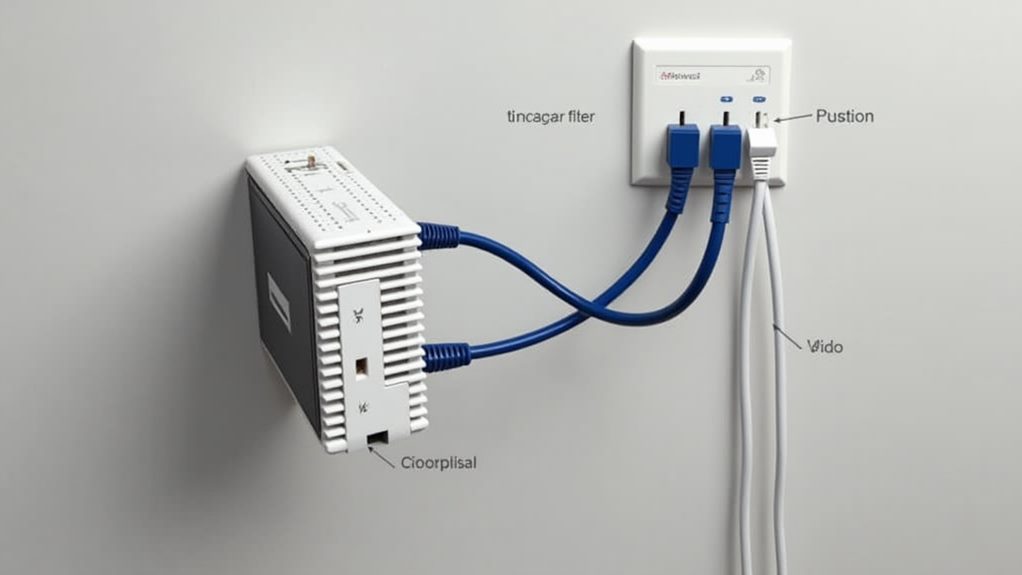BT isn't a standard VoIP provider but rather offers a proprietary VoIP implementation called BT Digital Voice. You'll need their specific Smart Hub 2 router to use the service, as it operates within BT's closed ecosystem. Unlike traditional VoIP protocols that allow interoperability, BT's system restricts you to their infrastructure and equipment, limiting your ability to port numbers or integrate with third-party solutions. The service is part of the UK's shift from copper-based phones to internet-based solutions by December 2025. Understanding BT's distinct technical architecture will help you make informed decisions about your communication needs.
Understanding BT Digital Voice Service

BT Digital Voice represents a proprietary VoIP implementation that's exclusively tied to BT's infrastructure and Smart Hub 2 router ecosystem.
When you join BT's broadband network, you'll become part of their innovative shift toward full-fiber technology, where traditional copper-based phone services are being replaced with internet-based solutions. This change aligns with BT's broader push for advanced VoIP solutions that enhance flexibility and efficiency in communication.
Your Digital Voice service operates through BT's Smart Hub 2, creating a closed system that guarantees reliable VoIP performance but limits your ability to transfer the service to other providers.
If you're considering switching internet service providers, you'll need to understand that your BT Digital Voice phones won't maintain connectivity, as they're specifically designed for BT's proprietary VoIP platform.
As the UK moves toward the December 2025 deadline for phasing out traditional phone services, you'll find yourself among the growing community of users adapting to VoIP technology.
BT's Digital Voice service positions you at the forefront of this telecommunications evolution, though it's important to recognize that your commitment to BT's ecosystem means remaining within their network infrastructure to maintain your phone service functionality.
Voip Vs BT Proprietary System
Comparing standard VoIP protocols with BT's proprietary system reveals fundamental architectural differences in how voice communications are handled. While traditional VoIP operates on open standards that allow interoperability between different providers and equipment, BT Digital Voice functions exclusively within its closed ecosystem, tethered to the Smart Hub 2 router.
This proprietary architecture restricts flexibility and integration, making it less appealing for users seeking broader compatibility. Additionally, BT's emphasis on VoIP technology fundamentals further underscores the divergence from standard VoIP implementations.
You'll find that BT's approach diverges considerably from standard VoIP implementations in several critical ways. The system's dependency on full-fiber connectivity and proprietary hardware creates a walled garden that prevents integration with third-party VoIP solutions.
You can't port your number to other providers or use alternative routers, which effectively locks you into BT's infrastructure.
Once you've switched to BT Digital Voice, you're operating within a distinct protocol framework that's incompatible with conventional VoIP standards. This means you won't be able to revert to traditional landline services or migrate to another VoIP provider without potentially losing your service.
The system's architecture guarantees that you're fully integrated into BT's network ecosystem, making it fundamentally different from the open, portable nature of standard VoIP implementations that many of us are familiar with.
Equipment Requirements and Limitations

In accordance with BT's proprietary ecosystem, the Digital Voice service imposes strict equipment requirements that considerably limit user flexibility and network configuration options.
You'll find yourself required to use BT's Smart Hub 2 router, which replaces any existing networking equipment you might've in place. This can be particularly frustrating for businesses looking to implement a more cost-effective solution that allows for greater customization and efficiency.
The limitations become particularly apparent when you're trying to integrate Digital Voice into your existing network setup.
You can't operate the Smart Hub 2 in modem or bridge mode, which means you'll need to adapt your entire network configuration to accommodate BT's requirements. This restriction affects your ability to maintain advanced networking setups or custom configurations you've previously established.
What's more concerning is that once you've switched to Digital Voice, you're effectively locked into BT's ecosystem.
You can't revert to traditional landline service, and your VoIP equipment choices become restricted to BT-compatible devices. If you're considering switching providers in the future, you'll discover that your Digital Voice phones likely won't work with other VoIP services, requiring additional investment in new equipment.
These proprietary limitations effectively create a technical barrier that ties you to BT's services long-term.
Network Compatibility Across Providers
When you're considering BT's Digital Voice service, you'll encounter distinct network architecture differences that limit interoperability with other ISPs' VoIP platforms.
Your ability to integrate BT's proprietary VoIP services across different providers' networks is restricted by BT's closed ecosystem and specific protocol requirements.
The hardware compatibility issues become apparent when attempting to use BT's Digital Voice equipment on alternative networks, as the Smart Hub 2 and associated VoIP devices are designed to function exclusively within BT's infrastructure.
Provider Network Architecture Differences
BT's proprietary VoIP architecture creates significant network compatibility challenges across different Internet Service Providers. When you're using BT's Digital Voice service, you'll find yourself locked into their specific network infrastructure, as the service requires BT's proprietary equipment like the Smart Hub 2. This means you can't simply transfer the service when switching to another ISP.
The technical differences between providers' network architectures become apparent when you examine their VoIP implementations. While BT's Digital Voice operates on their closed ecosystem, other ISPs maintain different network configurations and protocols.
You'll notice these distinctions particularly in how the voice traffic is handled and routed through their respective networks. If you're considering a provider switch, you'll need to understand that third-party VoIP solutions offer an alternative, though they'll require different setup parameters than BT's proprietary equipment.
As the industry moves toward complete VoIP adoption by 2025, you'll find varying levels of compatibility between different providers' infrastructures. Your number portability and service continuity may be affected due to these architectural differences, making it essential to evaluate your options carefully before changing between providers.
Cross-Platform Service Integration
Network compatibility across VoIP platforms presents significant challenges with BT's Digital Voice service due to its closed ecosystem design.
The service's exclusive reliance on the BT Smart Hub 2 router creates integration barriers when you're contemplating changes between providers or implementing multi-platform solutions.
When evaluating cross-platform integration options, you'll need to take into account these critical factors:
- Digital Voice's proprietary infrastructure limits your ability to maintain service continuity when switching ISPs
- Number portability restrictions prevent transferring your Digital Voice number to alternative VoIP providers
- Third-party VoIP systems operate independently of BT's ecosystem, offering greater flexibility
- The BT Smart Hub 2 requirement means you can't use Digital Voice with other router solutions
You'll find that third-party VoIP services offer more versatile integration options compared to Digital Voice's closed system.
While you can't port your Digital Voice number to another provider, you can implement alternative VoIP solutions that support cross-platform compatibility.
This approach guarantees you're not locked into a single provider's ecosystem and maintains your communication flexibility when changing between services or implementing multi-provider solutions.
Hardware Compatibility Issues
Hardware incompatibility presents a significant technical barrier when migrating between BT's Digital Voice and other ISPs' VoIP solutions.
You'll find that BT's proprietary system requires specific equipment, particularly their Smart Hub 2 router, which won't work with other providers' networks. This lock-in means you'll lose access to Digital Voice services if you switch to a different ISP.
When you're planning to change providers, you'll need to evaluate alternative VoIP solutions that are compatible with your new ISP's infrastructure.
Third-party VoIP systems offer a workaround, but they'll require different hardware setups that align with your new provider's specifications. It's essential to verify that your chosen VoIP service supports number portability, guaranteeing you can keep your existing phone number during the shift.
Before making the switch, you'll want to research thoroughly which VoIP providers integrate seamlessly with your prospective ISP's network.
This preparation helps avoid service interruptions and guarantees continuous connectivity.
Remember that while BT's Digital Voice offers a thorough solution within their ecosystem, its proprietary nature means you'll need to plan carefully for hardware compatibility when evaluating other Internet Service Providers.
Cost Structure and Pricing

Understanding the cost structure of BT's Digital Voice service requires examining several key financial components. When you're considering the shift to BT's VoIP platform, you'll encounter a pricing structure that's both thorough and proprietary in nature. The service operates through BT's Smart Hub 2 router, which you'll need to factor into your initial investment calculations.
Key cost considerations include:
- Mandatory Smart Hub 2 router requirements, which may necessitate additional equipment expenses
- Pricing packages that vary based on your calling needs and usage patterns
- No direct number portability fees, though previous provider cancellation charges may apply
- Limited flexibility in transferring VoIP numbers due to BT's proprietary system
For business users, BT's Cloud Voice offers scalable pricing plans that accommodate different organizational needs. You'll find competitive rates for various call packages, including international options.
However, it's essential to understand that you're investing in a closed ecosystem – while the Digital Voice service integrates seamlessly with existing hardware, you won't be able to port your number to other providers, which could impact your long-term cost management strategy.
Service Migration and Number Porting
When migrating to BT's Digital Voice service, you'll experience a structured change process that requires porting your existing phone number to BT's VoIP infrastructure using their Smart Hub 2 router.
You'll need to explicitly request number portability during the migration process, as BT's system operates on proprietary protocols that don't interface directly with other VoIP providers' networks.
Your service may face brief interruptions during the porting phase, and you should be aware that if you later switch to a different ISP, you won't be able to transfer your Digital Voice number to another VoIP provider's platform.
Number Transfer Process Explained
Moving from BT to a VoIP provider requires a carefully managed number transfer process to maintain service continuity. When you're initiating the shift, you'll need to explicitly request number portability during the signup phase with your new VoIP provider. The process is designed to be cost-free and seamless, allowing you to retain your existing phone number while upgrading to modern VoIP technology.
Key aspects of the number transfer process include:
- Your new VoIP provider will manage all number portability requests on your behalf
- The transfer process begins automatically once you've completed the signup requirements
- BT's role is limited to initial setup, with control transferring to your new provider
- Success isn't guaranteed, and you may need a contingency plan for a new number
To optimize your chances of a successful transfer, maintain clear communication with your new provider throughout the process.
They'll serve as your primary point of contact and handle all technical aspects of the number portability request.
While BT's involvement diminishes after the initial stages, your new provider becomes responsible for managing your telephony services once the transfer is complete.
Service Transition Common Issues
Numerous technical challenges can arise during service changes to or from BT's Digital Voice platform, particularly in the domain of number porting and service migration.
You'll find that BT's proprietary system requires specific hardware configurations, particularly the Smart Hub 2 router, which can complicate your shift process if you're moving from traditional landline services.
When you're moving to BT Digital Voice, you'll likely experience temporary service interruptions during the number porting phase. This downtime isn't always clearly communicated, leading to widespread customer dissatisfaction.
You'll want to be especially cautious if you're considering switching Internet Service Providers, as BT's closed ecosystem prevents the porting of VoIP numbers to other providers. This limitation effectively binds you to their service infrastructure.
The service shift becomes especially complex if your new provider doesn't support BT's proprietary system, potentially resulting in complete loss of voice connectivity.
You'll need to carefully evaluate your options and timing before initiating any changes. The lack of transparency in BT's communication about these technical constraints often leaves you discovering these limitations only after you've committed to the service.
Alternative VoIP Solutions

Subscribers looking beyond BT's Digital Voice can tap into a diverse ecosystem of third-party VoIP providers that offer enhanced flexibility and cost-effective solutions.
These alternative providers deliver competitive service packages without tying you to proprietary BT infrastructure, allowing greater freedom in your telephony choices while maintaining your existing number.
Consider these key advantages when exploring alternative VoIP solutions:
- Cross-platform compatibility with various Internet Service Providers, guaranteeing continuous service during network shifts
- Competitive pricing structures, with providers like Voipfone offering basic packages from £3/month (ex VAT)
- Free internal calling between users on the same VoIP network, optimizing cost efficiency
- Number portability options that let you retain your existing telephone number
When evaluating alternative providers, you'll need to verify technical compatibility with your current network setup and confirm your internet connection meets the minimum requirements for VoIP protocol standards.
Many providers offer extensive migration support, helping you navigate smoothly from traditional telephony or other VoIP services.
This approach gives you more control over your communication infrastructure while potentially reducing operational costs through optimized service packages.
Security and Reliability Features
With industry-leading security protocols at its core, BT Cloud Voice deploys an extensive defense infrastructure managed by 3,000 security experts who actively combat over 6,500 daily cyber threats. This robust security framework guarantees your VoIP communications remain protected against unauthorized access and potential breaches, maintaining the highest standards of data protection and privacy.
You'll benefit from BT's commitment to reliability through thorough service level agreements that guarantee consistent uptime and call quality. The network prioritizes your VoIP traffic over standard internet data, utilizing ultra-low latency infrastructure to deliver crystal-clear voice communications that match traditional phone systems' performance.
When you're part of the BT Cloud Voice network, you're backed by Gartner-recognized excellence in network service provision. You'll have access to 24/7 dedicated support, guaranteeing any technical issues are resolved promptly to maintain uninterrupted service.
The support team's expertise covers everything from basic troubleshooting to complex network configurations, demonstrating BT's commitment to keeping your business communications running smoothly. This combination of security measures, reliability guarantees, and professional support makes BT Cloud Voice a trusted choice for organizations prioritizing secure, dependable VoIP services.
Business Voice Communication Options

BT's Cloud Voice delivers enterprise-grade VoIP functionality through its unified communications platform, allowing you to integrate your voice, video, and messaging protocols into a centralized system for teams of five or more users.
You'll access scalable telephony options through customizable call packages, including UK and international Call Sharer plans that accommodate your organization's expanding communication requirements.
The platform's digital integration capabilities enable you to manage your communication infrastructure through a web portal, connecting your workforce across multiple devices while maintaining HD voice quality standards.
Enterprise Cloud Voice Features
Modern enterprise telephony demands robust feature sets, and BT Cloud Voice delivers extensive unified communications capabilities through its VoIP platform. As a thorough communication solution, it integrates essential business functions while maintaining superior call quality across the network infrastructure.
For business users seeking enterprise-grade features, BT's platform offers:
- High-definition voice transmission with guaranteed service level agreements for consistent performance
- Scalable call packages featuring unlimited UK calls and flexible international minute bundles
- Advanced video conferencing capabilities for seamless remote collaboration
- Integrated call recording functionality for compliance and quality assurance
The system's architecture prioritizes reliability and accessibility, ensuring your organization maintains continuous communication channels.
You'll benefit from round-the-clock technical support and thorough training resources, enabling your team to maximize the platform's potential. The VoIP infrastructure supports multiple concurrent calls while maintaining crystal-clear audio fidelity, essential for professional business communications.
BT Cloud Voice's enterprise features align with modern business requirements, offering the flexibility to scale services according to your organization's needs while providing the security and stability expected from a tier-one telecommunications provider.
Scalable Phone System Options
Multiple scalable phone system configurations enable businesses to customize their BT Cloud Voice deployment according to specific operational requirements.
You'll find flexible options through UK Call Sharer packages and International Call Sharer bundles, letting you allocate minutes across fixed and mobile calls based on your team's communication patterns.
As a VoIP provider, BT guarantees you can scale your communication capabilities up or down to match your business needs.
You're able to integrate pre-configured IP phones and headsets instantly, eliminating complex setup procedures while maintaining enterprise-grade voice quality.
The system's architecture supports your remote and hybrid workforce through unified calling, meeting, and messaging functionalities.
Your scalability options extend beyond basic telephony, incorporating high-definition voice quality and video conferencing features that grow with your organization.
BT's 24/7 support infrastructure guarantees your system maintains peak performance as you expand.
When you're ready to scale, you won't need to overhaul your existing setup – the cloud-based platform adapts to accommodate additional users, features, and locations while preserving your current configurations and security protocols.
Digital Integration Capabilities
Integration across unified communications platforms sits at the core of BT's Digital Voice architecture, enabling seamless connectivity between SIP-based protocols and legacy systems.
You'll find that BT's VoIP infrastructure leverages your existing broadband connection to deliver enterprise-grade telephony solutions through their Smart Hub 2 ecosystem.
When you're implementing BT Cloud Voice, you'll gain access to these essential integration capabilities:
- Real-time synchronization with your existing communication infrastructure
- Seamless interoperability between Digital Voice and traditional telephony systems
- Full compatibility with current broadband networks and SIP trunking protocols
- Native support for high-definition voice codecs and quality-of-service prioritization
The technical framework of BT's Digital Voice platform guarantees you're connected to a robust network architecture that supports your business communication needs.
Your organization can leverage the advanced features of Cloud Voice while maintaining compatibility with existing systems.
The integration capabilities extend beyond basic telephony, incorporating unified messaging, presence management, and collaborative tools.
This thorough approach means you're not just adopting a VoIP solution – you're joining a fully integrated digital communications ecosystem that scales with your business requirements.
Future of Phone Services
Concerning the future landscape of telephony, BT's changeover to VoIP technology by December 2025 represents a significant shift in telecommunications infrastructure.
You'll find that your traditional landline will become obsolete as the network evolves to a fully digital framework, requiring you to evaluate how this affects your existing number and service continuity.
The change means you'll need to reflect on how this affects your existing number and service continuity.
BT's Digital Voice service will operate exclusively through their Smart Hub 2 router, integrating your phone services directly with your broadband connection.
However, you'll want to note that if you're planning to switch providers, you'll need to verify compatibility with other ISPs' VoIP solutions, as BT's Digital Voice service won't work with alternative providers.
This industry-wide shift is creating a more competitive marketplace, where you'll have access to enhanced features and potentially better pricing options.
All major ISPs are developing their own VoIP solutions, giving you more choice in how you maintain your phone connectivity.
The key will be ensuring your chosen provider can support your communication needs while maintaining the flexibility to port your existing number if needed.
Final Thoughts
You'll find BT has evolved beyond traditional telephony into a hybrid telecommunications provider, offering Digital Voice service that rides on IP networks. Like light pulsing through fiber optic cables, your voice travels as data packets across BT's infrastructure. While utilizing VoIP protocols (SIP/RTP), BT's system integrates proprietary elements, making it a specialized VoIP-adjacent service rather than a pure VoIP platform. Consider it a managed voice network operating within BT's broader digital ecosystem.

